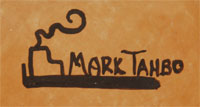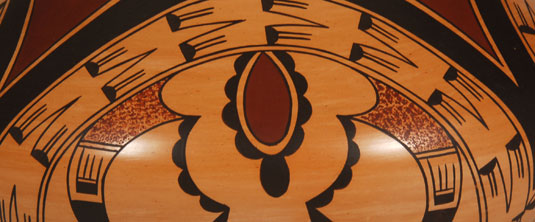Hopi Polychrome Jar with Deep Red Pigment [SOLD]
+ Add to my watchlist Forward to Friend
- Category: Modern
- Origin: Hopi Pueblo, Hopituh Shi-nu-mu
- Medium: clay, pigments
- Size: 5-1/2” height x 8-3/4” diameter
- Item # 25855 SOLD
 When Mark Tahbo delivers pottery to the gallery he always spends considerable time explaining each and every item of design. He treats each vessel as a special item and wants to be sure that we understand what he did and why he did it. I sometimes wish I had recorded his words rather than attempting to remember them.
When Mark Tahbo delivers pottery to the gallery he always spends considerable time explaining each and every item of design. He treats each vessel as a special item and wants to be sure that we understand what he did and why he did it. I sometimes wish I had recorded his words rather than attempting to remember them.
In this jar, Mark said he had in mind to made the shape a jar and not a seed jar so it is more upright than shallow in depth. The deep burgundy color around the neck is from rock, not clay. It is a rock he finds at Hopi and he laboriously grinds it up to make the pigment. Because it is from rock, it cannot be stone polished but has to be left in matte finish. The black painted designs come out with a deep black where in most other Hopi pottery the color is brown.
Each of the four major design sections is different. He did not repeat the same pattern in each so as to provide more interest for a collector to study each panel and rotate the jar to the position desired and to be able to see a different design at different times. Just below the deep burgundy paint are wide black bands which set the upper frame for the design below. The one-inch wide design below the wide black band is a series of elements that Mark said are defined in Barbara Kramer’s book as katsina faces—the idea coming from the two half-moon black elements seen as eyes and the long V mark as perhaps the nose. It is easy to see that interpretation. Mark says, however, that they are cloud elements and rain.
From that point, each of the four panels has a unique design, all of which rely on prehistoric Sikyatki designs and designs used by Nampeyo, but each presented in the manner Mark wished to do so that they were not exact copies of previously seen designs. One of the design elements is a variation of the long curved abstract bird design seen in many of Nampeyo’s bowls, but Mark put it on a jar and interpreted it in his manner. Another panel features the eagle tail design from Sikyatki but greatly modified by Mark. A third panel is a variation of another abstract bird with a more elaborate tail resembling the tail of a scorpion. The fourth design is similar to the Hopi bat wing element but is highlighted with an elongated medallion of deep burgundy color. All the stippling in the design was executed in the burgundy stone pigment.
Within each of the designs, Mark has an explanation for why he did what he did and what, if any, meaning there was to each element. His analysis is a clear indication that he tries to be unique in his work and to make each pot unique in its own way. As I told him, I have never seen anyone be more precise in painting designs. There is no looseness to his work, only perfection.
Condition: new
Provenance: from the artist
Reference: Nampeyo and Her Pottery by Barbara Kramer

- Category: Modern
- Origin: Hopi Pueblo, Hopituh Shi-nu-mu
- Medium: clay, pigments
- Size: 5-1/2” height x 8-3/4” diameter
- Item # 25855 SOLD



